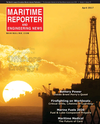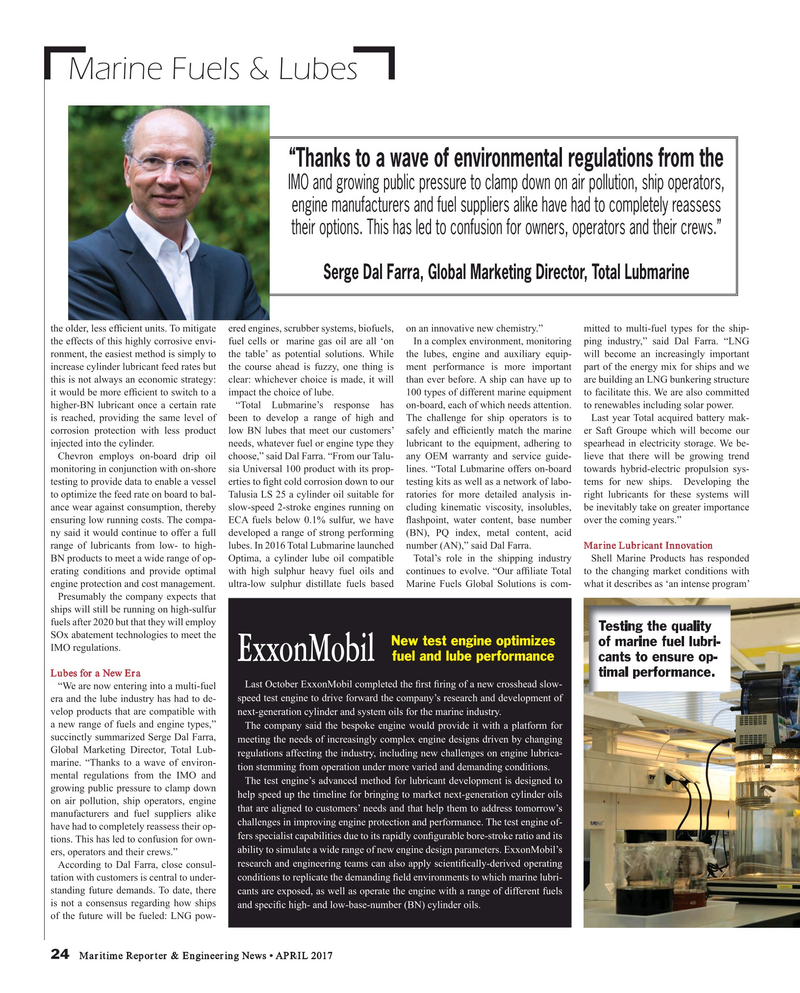
Page 24: of Maritime Reporter Magazine (April 2017)
The Offshore Annual
Read this page in Pdf, Flash or Html5 edition of April 2017 Maritime Reporter Magazine
Marine Fuels & Lubes “Thanks to a wave of environmental regulations from the
IMO and growing public pressure to clamp down on air pollution, ship operators, engine manufacturers and fuel suppliers alike have had to completely reassess their options. This has led to confusion for owners, operators and their crews.”
Serge Dal Farra, Global Marketing Director, Total Lubmarine the older, less ef? cient units. To mitigate ered engines, scrubber systems, biofuels, on an innovative new chemistry.” mitted to multi-fuel types for the ship- the effects of this highly corrosive envi- fuel cells or marine gas oil are all ‘on In a complex environment, monitoring ping industry,” said Dal Farra. “LNG ronment, the easiest method is simply to the table’ as potential solutions. While the lubes, engine and auxiliary equip- will become an increasingly important increase cylinder lubricant feed rates but the course ahead is fuzzy, one thing is ment performance is more important part of the energy mix for ships and we this is not always an economic strategy: clear: whichever choice is made, it will than ever before. A ship can have up to are building an LNG bunkering structure it would be more ef? cient to switch to a impact the choice of lube. 100 types of different marine equipment to facilitate this. We are also committed higher-BN lubricant once a certain rate “Total Lubmarine’s response has on-board, each of which needs attention. to renewables including solar power. is reached, providing the same level of been to develop a range of high and The challenge for ship operators is to Last year Total acquired battery mak- corrosion protection with less product low BN lubes that meet our customers’ safely and ef? ciently match the marine er Saft Groupe which will become our injected into the cylinder. needs, whatever fuel or engine type they lubricant to the equipment, adhering to spearhead in electricity storage. We be-
Chevron employs on-board drip oil choose,” said Dal Farra. “From our Talu- any OEM warranty and service guide- lieve that there will be growing trend monitoring in conjunction with on-shore sia Universal 100 product with its prop- lines. “Total Lubmarine offers on-board towards hybrid-electric propulsion sys- testing to provide data to enable a vessel erties to ? ght cold corrosion down to our testing kits as well as a network of labo- tems for new ships. Developing the to optimize the feed rate on board to bal- Talusia LS 25 a cylinder oil suitable for ratories for more detailed analysis in- right lubricants for these systems will ance wear against consumption, thereby slow-speed 2-stroke engines running on cluding kinematic viscosity, insolubles, be inevitably take on greater importance ensuring low running costs. The compa- ECA fuels below 0.1% sulfur, we have ? ashpoint, water content, base number over the coming years.” ny said it would continue to offer a full developed a range of strong performing (BN), PQ index, metal content, acid range of lubricants from low- to high- lubes. In 2016 Total Lubmarine launched number (AN),” said Dal Farra. Marine Lubricant Innovation
BN products to meet a wide range of op- Optima, a cylinder lube oil compatible Total’s role in the shipping industry Shell Marine Products has responded erating conditions and provide optimal with high sulphur heavy fuel oils and continues to evolve. “Our af? liate Total to the changing market conditions with engine protection and cost management. ultra-low sulphur distillate fuels based Marine Fuels Global Solutions is com- what it describes as ‘an intense program’
Presumably the company expects that ships will still be running on high-sulfur fuels after 2020 but that they will employ
SOx abatement technologies to meet the
New test engine optimizes
IMO regulations.
fuel and lube performance
ExxonMobil
Lubes for a New Era
Last October ExxonMobil completed the ? rst ? ring of a new crosshead slow- “We are now entering into a multi-fuel era and the lube industry has had to de- speed test engine to drive forward the company’s research and development of velop products that are compatible with next-generation cylinder and system oils for the marine industry. a new range of fuels and engine types,”
The company said the bespoke engine would provide it with a platform for succinctly summarized Serge Dal Farra, meeting the needs of increasingly complex engine designs driven by changing
Global Marketing Director, Total Lub- regulations affecting the industry, including new challenges on engine lubrica- marine. “Thanks to a wave of environ- tion stemming from operation under more varied and demanding conditions.
mental regulations from the IMO and
The test engine’s advanced method for lubricant development is designed to growing public pressure to clamp down help speed up the timeline for bringing to market next-generation cylinder oils on air pollution, ship operators, engine that are aligned to customers’ needs and that help them to address tomorrow’s manufacturers and fuel suppliers alike challenges in improving engine protection and performance. The test engine of- have had to completely reassess their op- fers specialist capabilities due to its rapidly con? gurable bore-stroke ratio and its tions. This has led to confusion for own- ability to simulate a wide range of new engine design parameters. ExxonMobil’s ers, operators and their crews.” research and engineering teams can also apply scienti? cally-derived operating
According to Dal Farra, close consul- tation with customers is central to under- conditions to replicate the demanding ? eld environments to which marine lubri- standing future demands. To date, there cants are exposed, as well as operate the engine with a range of different fuels is not a consensus regarding how ships and speci? c high- and low-base-number (BN) cylinder oils.
of the future will be fueled: LNG pow- 24 Maritime Reporter & Engineering News • APRIL 2017
MR #4 (18-25).indd 24 MR #4 (18-25).indd 24 4/4/2017 2:02:25 PM4/4/2017 2:02:25 PM

 23
23

 25
25
